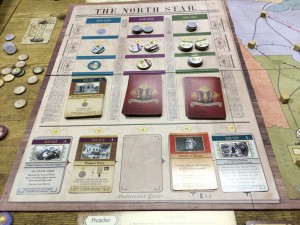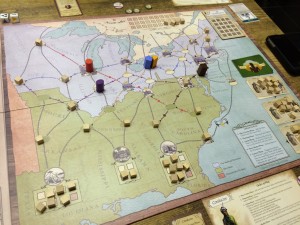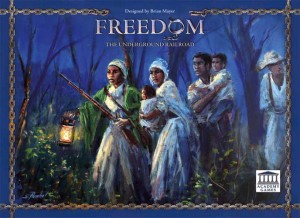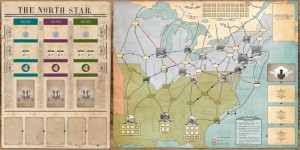Review: Freedom
Posted by James (admin) on June 2nd, 2014
Freedom: The Underground Railroad is a co-operative game of freeing slaves in 19th Century America. The board shows the Eastern United States with routes between cities. Slaves (represented by cubes) start in the 3 plantation areas in the South and players try to move them across the States to freedom in Canada. There are also 5 different coloured/shaped slave catchers on the board who move along their own paths (primarily running East-West) throughout the game.
The goal is to get enough slaves to Canada before the game ends after a fixed number of rounds; however, players can only win if they also get enough support for the abolitionist movement (by buying every support counter), plus the game immediately ends in failure if too many slaves are lost. The numbers of freed slaves required, support tokens, tokens that move slaves and generate income, and maximum lost slaves are all based on the number of players and the difficulty level (normal or hard).
Each turn is broken into several phases. First, dice are rolled and the corresponding slave catcher is moved accordingly. If a slave catcher moves onto a city where slaves are located, all of those slaves are captured. Capture means being added to the slave market cards at the side of the board – these cards show the slaves that will be added to the plantations at the end of each turn.

The left of the board shows the tokens and cards available split into eras and the cards that can be bought.
Next, each player takes up to 2 tokens from those available – tokens that move slave cubes and that represent support for the abolitionists cost money; whereas, tokens that generate income are free. The game covers 3 eras and all tokens are limited in number within each era. The next era opens up when all the support tokens are purchased in the latest era. This means you’re constantly driven to purchase support tokens to ensure there is a decent supply of movement and income tokens – however, even with all the tokens available, you usually find yourself thinking how few tokens there are for how much you need to accomplish.
Once all players have selected tokens, players take turns using up to 2 of their tokens to earn income and move slaves. Moving slave cubes is a very interesting challenge. Any slave ending its movement on a city generates income for the player moving it (representing contributions from sympathisers) – you quickly find money is not easy to come by and generating income this way is vital. However, ending movement on a slave catcher’s route (and most cities are on at least one) will draw the slave catcher one space towards the slave, capturing any slaves they land on. So, you start to find yourself in an ever-tightening jam of slaves and catchers. To solve this, you can purposefully move slaves to draw slave catchers in one direction and then back in another – although this is easier said than done, especially as few spaces can be occupied by more than one slave. Sometimes it’s worth allowing a slave to be captured for a greater gain elsewhere.
At the end of each round, slaves on the next slave market card must be added to the plantations – any that can’t fit onto these are immediately lost and the players immediately lose if too many are lost. So, it’s essential that you keep slaves moving out of the plantations, even later on in the game when you want to focus on moving slaves already in the States across the border into Canada.
Each player has a role card which gives them a one-use power and an on-going ability too, such as moving a couple of slaves for free. There are also cards that can be bought which give various instant or on-going effects – the more rounds they are available, the cheaper they get before being discarded. Some cards have impactful negative effects whilst they are in the queue, or when discarded from the queue, so players also need to manage these too. In one game, we purposefully kept a mild negative card in the queue for some time just to stop worse ones entering.
Overall, Freedom is an excellent game of logistics. It seems simple to start with when you have cash, and there’re lots of places to move slaves and lots of tokens to purchase. However, you soon find yourself trying to solve desperate cash shortages with few tokens available, and a traffic jam of slaves and slave catchers.
You feel constantly stretched (apart from the blissfully naive first part of your first game when you don’t yet know how tricky it will become). Income is a tricky challenge as you need money to buy tokens to move the slaves but to get more income tokens (by opening the next era) means buying expensive support tokens which requires money. Also, movement presents its own challenges as not only do you need to move slaves carefully so they earn income and don’t get captured, but you also need to keep them moving in all areas of the board so enough reach Canada but also those in the plantations keep moving out so the newly arriving slaves have somewhere to go too. This makes Freedom a highly entertaining, and enjoyably stressful experience.
As with most co-op games, some players can feel a bit left out if more vocal/dominant players are playing, so you need to manage that, but it depends on your group. I found it plays equally as well as a solo game too which you can still play as if multiple players are involved. I would probably prefer to play with 2 or 3 players as it’s hard for everyone to be equally involved with 4 players.
I have a strong interest in the American Civil War and this game is a superb subject matter to cover during this period. The game and theme feel well-connected – the board looks great and the historical photos, names, events and background text on the cards really add to the thematic feel.
With regards to replayability, the type of decisions required will be similar each game, although the circumstances will vary quite a lot (kind of like Pandemic and Forbidden Island). The random slave catcher movement and the cards that appear will require different responses, and the position of slaves and catcher will vary due to the combinations of actions and movements. There are 6 different roles to choose from so there’s some variety to be had with different mixtures of those too, as you can only use a maximum of 4 in any game.
A small element of luck is added via the random slave catcher movement and the order in which the cards (positive and negative) appear. However, I felt this random element just created variety and something I needed to respond to so my performance was down to my actions and planning.
The only aspect I wasn’t very keen on was the physical pieces representing the slave catchers – circular card counters with coloured shapes printed on them (although I was given tall wooden pieces of different colours and shapes at Essen). Whilst these make the slave catchers easily recognisable (especially the wooden pieces), they stuck out because they are so abstract when everything else was so thematic. The card tokens could have had been cut to the matching shapes with coloured backgrounds but showing a slave catcher figure on them to be more thematic; however, this is a minor complaint.
In the end, I think Freedom is a thematic and entertainingly tough game of logistical challenge where any failure feels like it’s almost certainly my own doing; plus, it appeals to my historical interest too. You can read the rules and see the details of the game on Academy Games’s web site using this link: bga.me/freedom
James.
[Played with 1 player (1 & 3 roles) and 4 players (4 roles)]




